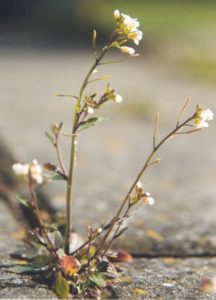
Fungi are among the most devastating pathogens of plants, including crops of major economic importance, and many vegetable crops. Several methods of control are commonly used to limit their pathogeny, including genetic and chemical controls.
However, both are frequently bypassed as fungal populations quickly evolving resistance to a variety of fungicides. The use of fungicides also appears to be a disaster at the ecological scale, and so a lot of efforts are being made to find other weapons against phytopathogenic fungi.
The 29th Fungal Genetic Conference took place at the Asilomar Conference Grounds in California, USA, and was an important occasion to give an overview of a new weapon in the antifungal arsenal: small interfering RNAs (siRNAs) and small RNAs (sRNAs).
What are siRNAs and sRNAs?
siRNAs are short (21-24 base pairs long) non-coding RNAs involved in the RNA-interference (RNAi) process, leading to the degradation of their specific messenger RNA (mRNA) target, thus inhibiting gene expression or translation.
RNAi occurs in two steps: first the cellular double-stranded RNA are degraded by the Dicer ribonuclease to form 21-24 base pair long RNA fragments. Those small RNAs are then transferred to the RNA-induced silencing complex (RISC), a multiproteic complex that cleaves the double-stranded RNAs into a single strand form. In the second step of the RNAi, those single-stranded RNAs target the RISC complex to the complementary RNAs, leading to their degradation by the RISC complex.
In recent years, more and more efforts have been made to adapt siRNA for use in crop protection.
The existence of siRNAs in plant-fungal interactions has been shown on both the fungal and the plant side. The plants siRNA activity has already widely used in plant science through techniques like Host-induced Gene Silencing (HIGS) in order to decrypt plant biology at the molecular level. In recent years, more and more efforts have been made to adapt siRNA for use in crop protection.
siRNAs and antifungal resistance
siRNAs are frequently used by fungal pathogens of plants, but also of mammals, like Mucor circinelloides, an opportunist pathogen. It has previously been shown that M. circinelloides can develop a transient resistance to the antifungal drug FK506 through RNA-interference, leading to silencing of the fungicide target gene.
In addition, scientists from the Duke University (USA) have shown that resistance to another fungicide (5-FOA) happens without mutations in the target genes, pyrF and pyrG (unpublished data presented during the congress). This resistance appears to be controlled, like resistance to FK506, by expression of siRNAs against the antifungal drug target genes, providing priceless clues about antifungal drug resistance mediated by siRNAs.
siRNAs and mycotoxins
siRNAs are also involved in the production of mycotoxins; toxic secondary metabolites secreted by fungi during plant-fungi interactions. Mycotoxins are a major contaminant on crops and some of them can cause severe diseases in humans, including cancer.
Mycotoxins are a major contaminant on crops and some of them can cause severe diseases in humans, including cancer.
Using HIGS, it has been possible to decipher how sRNAs affect the production of Deoxynivalenol (DON), an agronomically important mycotoxin produced by the wheat pathogen Fusarium graminearum. Those findings have important implications which could lead to a new eco-friendly way to control mycotoxin production by phytopathogenic fungi.
The most promising and exciting progress in siRNA research has been made by scientists from the University of California (USA). They highlighted a bidirectional trans-kingdom dialogue via siRNAs between phytopathogenic fungi and their host plant. They showed that siRNAs are widely used by Botrytis cinerea to infect more than 1000 host plants. Those siRNAs are translocated inside the plant cell, bypassing the plants defense systems., and constituting a novel class of effector protein involved in infection.
But above all, it was shown that an Arabidopsis plant expresses siRNA which targets B. cinerea genes involved in RNAi, and is able to circumvent fungal development. This finding lead those scientists to develop a Spray Induced Gene Silencing (SIGS) method. It appears that by applying synthetic siRNAs on plants usually challenged to fungal infection, you can help those plants to better resist the infection.
It appears that by applying synthetic siRNAs on plants usually challenged to fungal infection, you can help those plants to better resist the infection.
This finding has two potential openings. Firstly, a biotechnological tool could be made to silence fungal genes without the use of systems that are genetically tractable to vary gene expression, just by applying synthetic siRNAs under lab conditions. Secondly, a new way to control fungal epidemics in field could be developed through the dissemination of synthetic siRNAs by spray.
The future of siRNAs
Plant and fungal siRNAs open the way to a lot of tools both in biotechnology and in crop management. The dispersion by spray of synthetic siRNAs could solve a lot of problems posed by other methods of control. Importantly, this could be an eco-friendly way to control fungal diseases of crops, compared to the shockingly expensive cost of synthetic fungicides at the ecological scale.
However, it remains to be elucidated if those synthetic siRNAs are really “eco-friendly”: could they have an effect on the environment through non-specific silencing in other organisms in the field? Or could they affect human health? Those questions remain to be addressed before such treatments could be widely applied on crops.
Comments